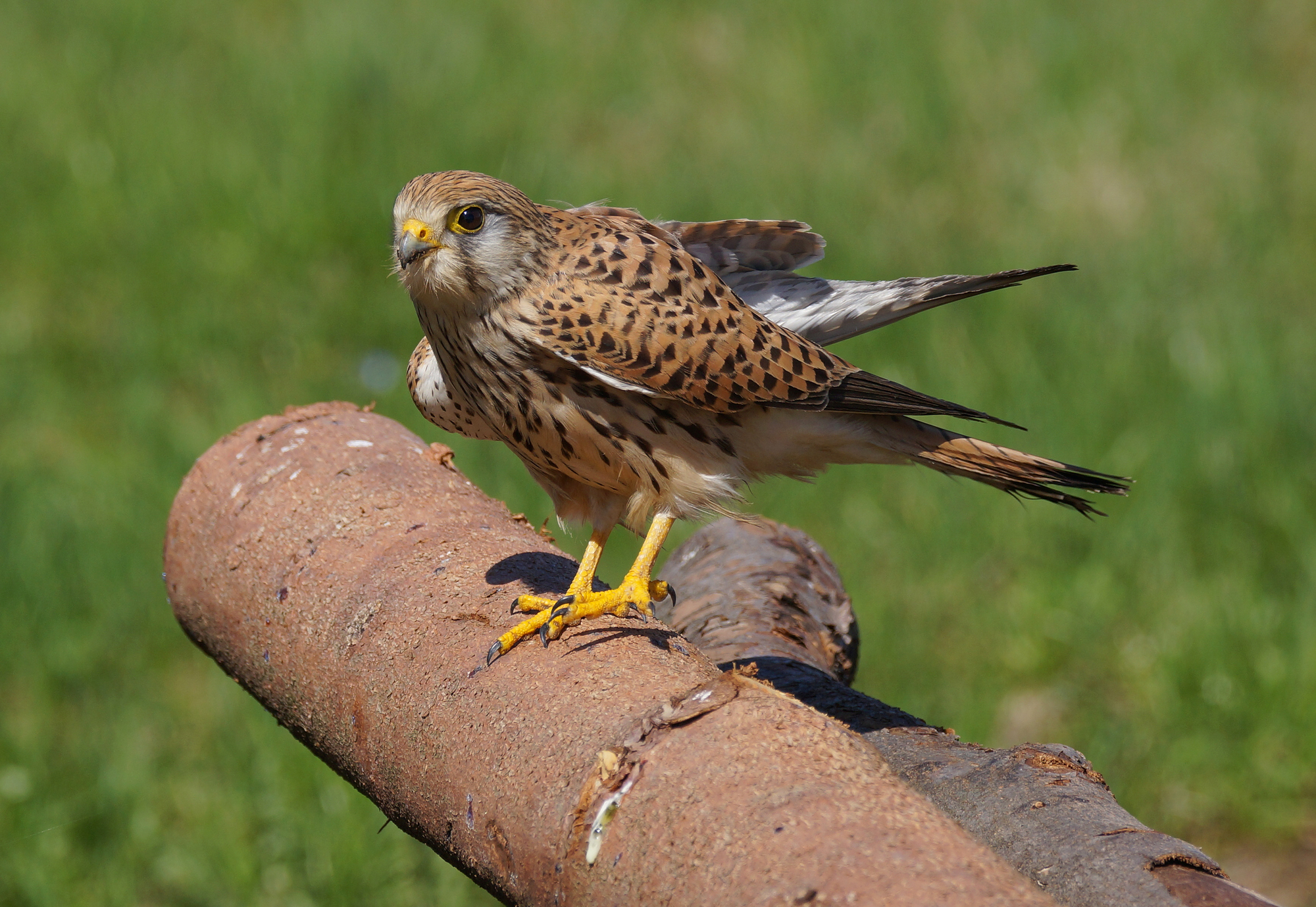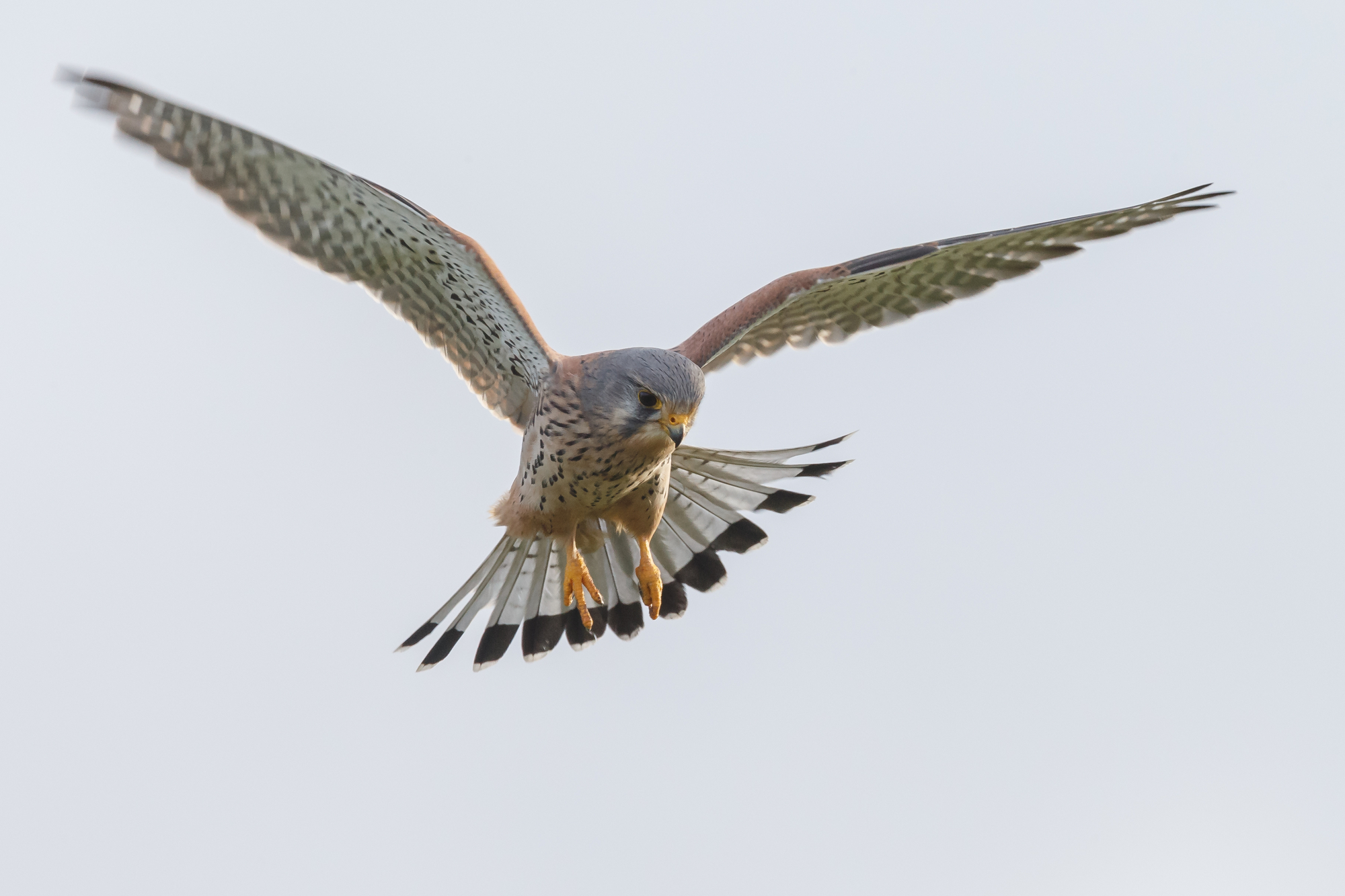The common kestrel (scientific name Falco tinnunculus) is a small passerine bird of the falcon family, which breeds across Europe and parts of Asia. It is a common species in many parts of the UK but is absent from much of North Africa and the Sahel region, southern Eurasia and Australia.
The kestrel name derives from Old French “cestre” meaning “a piece cut out”, likely referring to its distinctive tail shape.
How Do You Identify a Kestrel?
The common kestrel is an easy bird to identify. It is a small falcon, the smallest in Europe, similar in appearance to the hobbies and merlins but smaller with typically smaller, straighter wings. Adults have a distinctive long tapered tail that can be held tightly closed when perched. Its plumage is mostly grey above with pointed wings and belly, but white on the rump. The grey head on some species sometimes has a large white eye stripe, bordered by black ear tufts, and the underparts are white (typical of American kestrels). The legs are yellowish-brown.
The female’s plumage is more subdued than that of the male; it has streaking on its breast feathers rather than bold bands in either colour or both colours and lacks facial markings.
Kestrels are noted for hovering flight with their dotted wings curved or held crooked, powered by strong wing strokes alternating with periods of free flight.

Kestrel Diet and Hunting Habits
The kestrel bird usually hunts with its advantage of good sight, hovering at about head height above ground, waiting for prey activity below. It feeds mainly on small mammals such as voles, stoats, young rabbits, and weasels, as well as small birds, which it kills by piercing with its talons. In fact, it needs to eat several voles in a day to survive.
Kestrels typically hunt in open country such as fields or grassland for insects, lizards, mice and other rodents. They will also hunt on the wing, and occasionally take small mammals, amphibians and other vertebrates.
They typically seek out food from their perch and swoop down on their catch. Kestrels have an astonishing sight. They can spot a spider from 50 metres away and even see ultraviolet light, which helps them spot the urine trail of rodents.
Once a potential prey item is spotted, the common kestrel moves rapidly forward to intercept it, geometrically rising up and down before landing on its victim firmly upon initial contact. On capturing prey, the kestrel may either kill it by tearing off chunks or parts of flesh or by regurgitating stomach contents in an unconsumed form onto the victim.

Kestrel Breeding and Nesting
Mating is very similar in form to that of most other falcons, although it differs slightly in progression. The male kestrel bird usually flies above its mate and swoops down to take her. The females usually call out to the males shortly after the male makes contact with the female kestrel.
Once mating is complete, the kestrel will proceed to build nesting sites, often in holes in trees or an old building. The nest is often lined with straw, feathers and soft vegetable matter. It normally lays from 1–5 eggs that are white or sometimes bluish-green coloured and take around 33 days for incubation.
Is a Kestrel a Hawk Or Falcon?
Kestrels belong to the order Falconiformes, which includes falcons and other birds such as the red kite. They can be described as ‘typical falcons’ because they are unmistakable, similar to falcons in shape and build, but smaller.
However, although its name indicates that it is a member of the family Falconidae, kestrels are not even closely related to true hawks or falcons. The kestrel bird was not included in any previous listing of Falconidae, but was independently considered to be close enough to the accipitrids to warrant inclusion under Falco. As well as being larger than other falcons, its nest is very similar in form and structure to that of other wild nest-building birds such as crows, pigeons and starlings.
Kestrels are generally considered a subspecies of peregrine falcon (“F. peregrinus”), which are widespread across much of Eurasia.

Where Can I See a Kestrel?
The kestrel is a common species across the world. It prefers open habitats, but is also found in semi-open habitats, urban areas and farmland where forage for prey happens to be available. It has adapted well to human changes to the environment and can be found in areas with tall buildings or other man-made structures nearly everywhere humans are present.
There are many areas in the UK where kestrels are year-round common birds of prey. These include the south east, East Anglia, East Midlands and North East of England, Wales and Scotland. It is a familiar sight in some places but is more difficult to spot than some other birds of prey. This is because kestrels fly low over open country, usually close to the ground, looking for insects or small animals.

Kestrel Conservation Status In UK
In the past, kestrels suffered from persecution, particularly on grouse moors, but since 1958 it has been protected by law and persecution has been made illegal. They are common birds found throughout the UK except for Shetland.
Although there have been no nationwide surveys to estimate population size, this species appears to have undergone a relatively rapid period of widespread expansion in the mid-20th century, suggesting a stable or enlarging population level.
Sources and References
- The Kestrel Diet Along With A List of Their Favourite Foods – birdfeederexpert.com
- Kestrel (Falco Tinnunculus) – scottishwildlifetrust.org.uk
Sam loves to learn about animals and their habitats. He has been a nature lover from a very young age, and has been writing papers and articles about wildlife for as long as he can remember.
